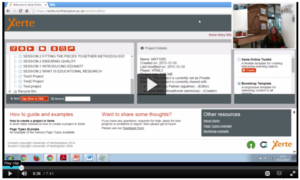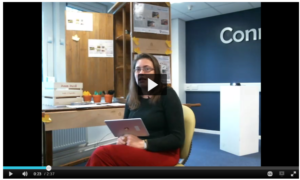Authors: Elizabeth Palmer, (University of Northampton, Learning Designer,) Sylvie Lomer, (University of Manchester, Lecturer in Education) and Ivelina Bashliyska (3rd Year Undergraduate Student and Assistant Researcher).
With thanks to Nadine Shambrooke and David Cousens for support with transcription and coding.
______________________________________________________________________
The University of Northampton has taken an institutional approach to learning and teaching through the widespread adoption of Active Blended Learning (ABL) as its new ‘normal’. To find out more please visit: https://www.northampton.ac.uk/ilt/current-projects/waterside-readiness/
However, student engagement has been highly variable, which has created a number of challenges for staff. Semi-structured qualitative focus groups have been undertaken with 201 undergraduate students across all the year groups and faculties during the academic year 16/17 based on a pilot study of 24 students in academic year 15/16. These focus groups have been looking at trying to uncover the students own perceptions and experiences of ABL in order to unpick the reasons behind varying patterns and engagements and to glean student insight into the factors that inhibit or encourage engagement with ABL.
The study has revealed a number of key factors which students identify as having significant impact on their engagement. Key success factors include effective pedagogical design, in particular establishing a clear and explicit relationship between online and face to face components of modules, and scaffolding the development of digital skills and literacies in the process of establishing online tasks. A strong relationship between staff and students is also critical, where students trust in the decisions and motivations of staff. This is signalled by following up on online tasks, providing feedback where relevant, and explicitly discussing the value of online tasks to module learning outcomes and employability skills. A key finding is that students’ conceptions of learning, teaching & knowledge impact on their engagement with ABL, and are not necessarily compatible with ABL principles. These factors are complex, interdependent and have varying loci of control. Staff can take a number of measures to increase the likelihood of student engagement, although certain factors remain ultimately within the agency of students. Understanding these issues is critical to the success of ABL.
The following artefacts provide the results of the study to date:
Read the Interim Report from the Main Study here:
For Ten Top Tips on how to design ABL to maximise student engagement:
Read the Pilot Study Report here:
Written by Sylvie Lomer and Elizabeth Palmer.
“Why should I even be doing this no one else can be bothered…”
“If I think it is going to benefit me then I will do it, if I don’t I won’t”
“It’s all so boring and hard, I can’t be bothered”
These are the kinds of phrases every teacher dreads overhearing in whispers in class, or in the corridors or even straight to our faces! Instead, we hope against hope for the student that at least trusts us enough to go with the flow….
“For me, I just do it anyway even if it’s not compulsory I’m probably going to do it because there’s a good reason someone has set it up”
…and even more so for that keen student, bright eyed at the front, hand raised, prepared and ready to go!
This blog post deals specifically with what might constitute ‘student engagement’ and the fact that it is often hard to tell what ‘non-engagement’ looks like. In addition, it hopefully goes some way towards establishing that there are different ways to support engagement and that both staff and students need to develop the right skills to foster high levels of engagement under active learning pedagogical models.
What is ‘Engagement’?
Active learning gives preference to group work, co-production, discussion and debate because its pedagogical underpinnings are based on relational and social learning theories. Engagement in these activities is, supposedly, easily observable. Students are either talking, writing, creating etc. or not. One of the difficulties faced by lecturers when moving to such models of learning is the discovery that engagement is not, in fact, as easy to measure as one might assume and that the characteristics of engagement that are easily observed in active learning favour more vocal and confident students. This may leave teachers with a group of students who are not observably participating in these activities. This gives rise to concerns about engagement and participation levels. Are those students that are not vocal, not participating, not creating or ‘doing’ the learning task not engaging and by proxy not learning?
If we begin by assuming that engagement is not necessarily:
-
Verbal
-
Written
-
Product-based
-
Observable
-
What teachers expect.
Then what is it and how do we support it?
Fredericks, Blumenfield and Paris (2004) talk about 3 dimensions to engagement: behavioural, emotional, and cognitive. This suggests that a student could exhibit what we might constitute as observable behaviourally positive engagement through regular attendance and completion of all tasks and assignments, but still be emotionally alienated by the material and therefore, not necessarily have learnt anything (cognitive engagement). In this example has the student ‘engaged’ and does that represent quality learning?
An online environment makes visible things which are present in traditional classrooms, but may remain implicit. In online contexts, for example, we might presume that to be engaged, students must be contributing to discussion boards, raising hands in virtual classrooms, writing blog posts, commenting on classmates’ contributions, and so on. But a small proportion of students are watching the discussions unfold. They may still be learning by watching. Indeed this is part of established learning models, such as Kolb’s learning cycle.
Undoubtedly, there are always some in a given group whose silence reflects confusion, uncertainty, sleepiness, or alienation. But arguably, it is possible to listen actively, to take effective notes and learn by doing so. Sometimes silence is an indicator of thought, of processing, of reflection, of listening.
Not all forms of engagement look the same. So how do you as a teacher determine whether silence is problematic or a different form of engagement?
If it’s online, set the tracker on each of your learning activities. You will be able to see who has accessed each learning activity, even if they have not made a written contribution. Contact them and ask what’s going on, non-confrontationally. Look for changes in patterns. A decline or shift in regularity of tracking patterns might indicate that the student is struggling. This requires regular involvement from the tutor, checking the statistics on the VLE and responding to individual students where appropriate.
If it’s face-to-face, ask questions as you circulate through the groups. Check in with students who seem quiet – have they understood the task? are the group dynamics excluding them? Think about whether they can participate in an alternative mode (e.g. make notes and pass them on). Make this check in personal – ask how they are, whether something is going on, this helps students to feel heard as an individual not just a collective.
Once you’ve determined that there is an engagement problem, the next step is to understand why.
What creates barriers to engagement?
Firstly, and fairly obviously, it’s worth considering prior assumptions about why students are not engaging. They may not be engaging for a number of reasons, some of which are outside their control. There is no meaningful category of ‘disengaged students’ and even students exhibiting “inertia, apathy, disillusionment, or engagement in other pursuits” (Krause, 2005, p.4) may have significant and understandable reasons. Indeed students experience different modes of engagement at different times as a continuum rather than as innate characteristics or traits. Whilst some modes of engagement may be desirable and some may not be, categorising students in relation to modes of engagement is unhelpful.
Students may be temporarily disengaged due to personal stress or concerns. They may be more permanently disengaged due to a fundamental breakdown in one or more of the three dimensions of engagement. If a student is in this situation, telling them to engage is probably not going to work. Asking them whether they are OK or why their engagement patterns have changed may be enough to show them that they are heard and seen as a whole person and they may consequently re-engage. Other times it may be necessary to implement a longer term strategy.
Often, it is necessary to address implicit requirements and skills for effective participation in learning activities. For example, many students in their first year are expected to engage in seminar debate and discussion. For many, this is a first. They may not have the requisite transferable skills of listening, building on contributions, negotiating, synthesising, and courteously disagreeing. These are sophisticated, high order thinking skills which are not innate to any of us. Scaffolding activities and modelling good practice, starting with easier tasks and concrete learning activities is vital.
Assumptions about requisite implicit skills extend to teachers as well. Facilitation of discussion and group work is an extremely challenging task and most of us have never been formally taught either how to formulate questions for discussion or how to stimulate and continue the discussion (or other learning activities). Anyone who has been to a conference will know that discussions do not emerge automatically and can be very difficult to manage. It is worth asking, therefore, whether it is our own uncertainties and fears, subconsciously perceived by students, that underlie disengagement. Beginning to address issues of engagement amongst a student cohort invariably starts with necessary self-reflection and personal development. Finding problems with engagement in our classes and recognising we need help is a particularly hard thing to admit to as it can feel like a loss of face. Often we try to identify a solution or solutions on our own, feeling unable to admit to the problem or indeed not knowing where, or from whom, to get support. Engaging in collaborative peer observation that is not in any way linked to performance management processes can be a start to this. Sometimes having a second pair of eyes and ears in the room can help spot things that it is difficult to do alone.
How do I improve engagement?
Our role as teachers, then, is to establish the conditions in which all students can and do engage in different ways at different times. Learning design, in all its facets, is the key means to tackling this effectively.
As a starting point this may mean reflecting on the content. Get engaged/ re-engaged yourself! Are you excited about this session/ module? Do you think this is a really interesting topic? Are you looking forward to spending time with your students? Are you keen to see what they learn and how they respond to the learning activities you have so carefully created? This must seem incredibly obvious, but often over the course of many years of teaching a subject, it is easy to underestimate the power of a teacher’s authentic emotions on the outcome of a class. The demands on a lecturer’s time and emotional energy have increased exponentially over the last few years and it is easy to become alienated ourselves from our discipline and our desire to educate. Our own well-being as practitioners has a significant impact on our students. A sense of excitement about learning and growth within our field is as important for us as it is for our students. Teachers can be gatekeepers for students into their profession, and modelling continuous learning and development offers opportunities to make learning relevant to future practice. If you can communicate your enthusiasm, students will pick up on your engagement. In an active learning model, having projects in your professional field that you are working on and enjoying can be a useful basis for case studies, work experience opportunities for your students, collaborative student research etc.
Secondly, be transparent, open and honest with respect to your pedagogy. If you’re not sure about something, or if you are trying something new and you don’t know how it’s going to work, tell your students. Ask them for their feedback and cooperation. Ask for their help. Most students will be delighted to be treated as equals in this scenario, and very few will take advantage of it. Student agency in the design and implementation of their learning is highly important and often a successful way of raising engagement in a cohort. Equally, give students some control and agency within the learning activities and tasks. For a given task, give choices about how to complete it. This can be individual or a group discussion about how best to complete the task – this is often a brilliant opportunity for meta-cognition or explicit reflection on learning. In relation to technology-enhanced learning this can also be a means of extending digital literacy within a class. Whilst you may not be aware of the range of technology available for a given task, the collective has a wider reach. Provide opportunities for students to share practice to extend learning and tech usage beyond themselves.
Thirdly, engage in staff development to increase your facilitation skills for both face-to-face and online environments, so that in group work you can effectively manage the dominant members of the group in order that there is space for more reticent students to develop their ideas. It can be helpful to alert students in advance so that they can prepare for the activities (e.g. tell them what the discussion topic will be). This gives students more time to process, collect their thoughts, develop arguments etc. before they are required to discuss the content with classmates. In a blended learning scenario, this can be a significant strength. Online preparation activities can be developed to allow students the time to reflect on issues, in advance of face-to-face sessions. Virtual classrooms allow students to raise their hands, ask questions and participate without being seen by the rest of the class. Therefore, use of virtual classrooms in addition to face to face sessions can offer alternative means of participation. Students that might never raise their hand in class normally, often do in an environment that offers greater anonymity and reduces the risk of embarrassment.
Coming back to the 3 dimensions to engagement – behavioural, emotional and cognitive – we can, and must, examine our learning activities and environments to foster all 3 dimensions.
What does that mean for how we understand ‘engagement’?
All of this suggests a need to re-conceptualise the notion of engagement. The key thing is the recognition that student engagement is the responsibility of both students and their institutions (including the teaching staff) (Witkowski, 2015; Morrison, 2014). Dealing with a ‘lack’ of student engagement should, therefore, not constitute a blame game. Instead it is about genuine, open and honest conversations about how learning should take place and what our mutual roles are between those involved in the learning. At Higher Education level the agency of the students is key but must be understood in the context of the structures within institutions. Here’s one possible, working definition:
Student engagement is concerned with the interaction between the time, effort, and other relevant resources invested by both students and their institutions intended to optimise the student experience and enhance the learning outcomes and development of students and development of students and performance and reputation of the institution (Trowler, 2010).
If any of the content of this blog post has caused you to want help in identifying or problem solving for engagement in your module please contact: LD@northampton.ac.uk
References
Fredricks, J.A., Blumenfeld, P.C. and Paris, A.H. (2004) School Engagement: Potential of the Concept, State of the Evidence. Review of Educational Research. 74 (1), pp. 59–109. In: Trowler, V. (2010) Student engagement literature review. Department of Educational Research, Lancaster University. The Higher Education Academy. Available at: http://www.lancaster.ac.uk/staff/trowler/StudentEngagementLiteratureReview.pdf (Accessed on 2nd September 2016)
Krause, K. (2005) Understanding and Promoting Student Engagement in University Learning Communities. Paper presented as keynote address: Engaged, Inert or Otherwise Occupied?: Deconstructing the 21st Century Undergraduate Student at the James Cook University Symposium ‘Sharing Scholarship in Learning and Teaching: Engaging Students’. James Cook University, Townsville/Cairns, Queensland, Australia, 21–22 September. In: Trowler, V. (2010) Student engagement literature review. Department of Educational Research, Lancaster University. The Higher Education Academy. Available at:http://www.lancaster.ac.uk/staff/trowler/StudentEngagementLiteratureReview.pdf (Accessed on 2nd September 2016)
Morrison, Charles D. (2014) “From ‘Sage on the Stage’ to ‘Guide on the Side’: A Good Start,” International Journal for the Scholarship of Teaching and Learning. 8 (1) Article 4. Available at:http://digitalcommons.georgiasouthern.edu/ij-sotl/vol8/iss1/4 (Accessed on 2nd September 2016)
Witkowski, Paula, & Cornell, Thomas. (2015). An Investigation into Student Engagement in Higher Education Classrooms. InSight: A Journal of Scholarly Teaching, 10, pp.56-67.
What are the factors that encourage and inhibit student engagement in online activities, such as e-tivities? This was the question that URBAN project run by Elizabeth Palmer, Sylvie Lomer, Laura Wood and Iveline Bashliyska sought to answer. This blog post outlines some of their findings.
Much research has been done into what makes a ‘good’ e-tivity (Swan, 2001; Sims et al., 2002; Lim et al., 2007; Salmon, 2013; Clark & Mayer, 2011; University of Leicester, n.d.):
- clear instructions and design,
- purposeful,
- perceived relevance,
- practice opportunities,
- interactive,
- structured pathways and sequencing,
- effective feedback
- interactions with the tutor
An amalgamation of tips gleaned from this research, such as Gilly Salmon’s “E-tivities: The Key to Active Online Learning” (available from the University library), and the experience of various University of Northampton staff who have been trialling e-tivities over the past year or so is available here: Tips for etivities and blended learning (PDF) It is not by any means definitive but might be helpful!
The Learning Development team (formally known as the Centre for Achievement and Performance: CfAP) offer a range of transferable cognitive and academic skills development opportunities for students, through both face-to-face and online delivery. Workshops delivered are embedded in subject courses and modules, on request from lecturers and module leaders. In the last year Learning Development has been modifying its delivery of workshops from a solely face-to-face model to a blended model of delivery in accordance with the University’s new pedagogical model. (See the Learning & Teaching Plan and information about Waterside for more detail). The aim of this approach was to provide online activities that would offer scalable opportunities for personalised, independent online learning that provide low pressure opportunities for students to practice academic skills and to maximize the impact of face to face time with students.
A variety of different approaches have been taken to this new blended delivery including; opportunities for structured writing practice; opportunities to shape the content of face-to- face workshops; discussion boards based around students’ concerns with academic and cognitive skills; preparatory writing exercises; interactive activities developing and modelling specific skills such as synthesis and formative individual feedback on written tasks. However, even when following good e-tivity design principles, student engagement with Learning Development designed e-tivities has varied markedly. For this reason a research project in LLS was undertaken to uncover more detail from students about their engagement with e-tivities. The project adopted qualitative methodologies involving students as co-researchers in order to uncover the causes and factors underpinning this variation, focus groups were conducted with staff and students involved in some of the blended learning activities at UoN.
The first finding was that students did not differentiate between CfAP activities and those of their module tutor. As a consequence it is possible to generalise the results as applicable to blended learning activities regardless of the tutor responsible for setting the activities.
The results can be seen to belong to one of two categories: ‘conditions’ for blended learning and ‘factors’ for student engagement. ‘Conditions’ are necessary and universal for all students; if the conditions cannot be met, successful engagement with blended learning through online activities is highly unlikely. Responsibility for conditions lies with staff and institutional policies and engagement. In contrast, the factors affecting student engagement are individual, personal and particular to the student, cohort and discipline. They do not lie entirely within the control of staff; that said they can be supported and bettered through effective educational practices. For example, a student may have low resilience for challenging activities and although staff can support the student in developing better resilience they cannot create resilience for the student; this constitutes a factor. Conversely, staff can establish accessible e-tivities and effectively communicate their purpose and how to complete them; this constitutes a condition.
The conditions and factors are as follows:
Fundamental conditions for Blended Learning:
- Staff engagement and student-staff relationship: This condition highlights the significance of staff motivations, beliefs and approaches to blended learning and relationships with student. Students nearly always mirror the staff’s views.
- Communication: This condition pertains to the requirement that communication between staff and students, around the purpose, pedagogical rationale and instructions for tasks, be fully transparent.
- Well designed VLE and online learning: This condition pertains to issues of design, navigation, layout etc.
Factors impacting engagement with blended learning:
- Student digital literacy and technology preferences: This factor indicates the extent to which individual student engagement with technology impacts variance in student engagement.
- Student beliefs and motivations about and for learning: This factor indicates the way that inherited beliefs about learning in general, and specifically in relation to each individual students patterns of learning, impacts their engagement with blended learning
- Student capacity for self-management: This factor pertains to variance in individuals ability to self-manage their learning and the impact this has on engagement with blended learning.
Initial findings were disseminated at this year’s LLS conference at the University of Northampton and the research team are now in the process of writing these results up for publication in the coming months. For the LLS conference presentation please visit:
For further information on these, please contact Elizabeth Palmer and Sylvie Lomer.
See also Julie Usher’s post on Getting Started with Blended Learning:
Recent article from TeachOnline.CA entitled “A New Pedagogy is Emerging… and Online Learning is a Key Contributing Factor” does a really fantastic job of outlining current trends in pedagogy and the role that online learning is playing within this new pedagogy. If you haven’t seen it, I recommend having a look!
In summary, the article outlines 7 key elements of current pedagogical thinking as follows:
“1. Blended learning
2. Collaborative approaches to the construction of knowledge/ building communities of practice.
3. Use of multimedia and open educational resources
4. Increased learner control, choice and independence
5. Anywhere, anytime, any size learning
6. New forms of assessment
7. Self-directed, non-formal online learning. “
All these aspects can be seen to underpin the Teaching & Learning plan we are moving towards at the University of Northampton. Blended or Hybrid learning is seen as the new normal where online and technology enhanced learning blend seamlessly with face-to-face workshop time. Significant emphasis is placed on group based learning and social interaction as well as the learner being at the centre of designing, implementing and reflecting on learning experiences.
George Dimmock talks about the ways in which Academic Librarians can support University of Northampton staff.
In this video Ali talks about experiences with online peer observation as part of a teaching qualification for University of Northampton staff.
Recent Posts
- Learning Technology Team Newsletter – Semester 2, 2023/24
- Getting started with AI: A guide to using the Jisc Discovery Tool’s new AI question set.
- Blackboard Upgrade – April 2024
- Exploring the Role of GenAI Text to Enhance Academic Writing: A Conversation with Learning Development Tutor Anne-Marie Langford.
- Interview with the University’s Digital Skills Ambassador
- Blackboard Upgrade – March 2024
- Case study: GenAI in BA Fashion, Textiles, Footwear & Accesories 2024
- Exploring the Educational Potential of Generative Artificial Intelligence: Insights from David Meechan
- Exploring the Fusion of Fashion and Artificial Intelligence: Jane Mills’ Pioneering Journey – Vulcan Sessions Talk.
- Artificial Intelligence Meets Drama: Matt Bond’s PlayAI Project Chronicles the Journey
Tags
ABL Practitioner Stories Academic Skills Accessibility Active Blended Learning (ABL) ADE AI Artificial Intelligence Assessment Design Assessment Tools Blackboard Blackboard Learn Blackboard Upgrade Blended Learning Blogs CAIeRO Collaborate Collaboration Distance Learning Feedback FHES Flipped Learning iNorthampton iPad Kaltura Learner Experience MALT Mobile Newsletter NILE NILE Ultra Outside the box Panopto Presentations Quality Reflection SHED Submitting and Grading Electronically (SaGE) Turnitin Ultra Ultra Upgrade Update Updates Video Waterside XerteArchives
Site Admin














